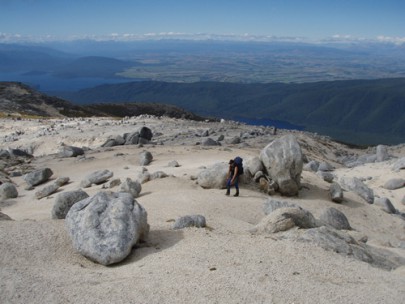Granitic gravel fields
In this section
-
Inland & alpine
- Basic cliffs, scarps and tors
- Boulderfields of acidic rocks (non-volcanic)
- Boulderfields of calcareous rocks
- Boulderfields of quartzose rocks
- Braided riverbeds
- Calcareous cliffs, scarps and tors
- Calcareous screes
- Cliffs, scarps and tors of acidic rocks
- Cliffs, scarps and tors of quartzose rocks
- Cloud forests
- Frost hollows
- Granitic gravel fields
- Granitic sand plains
- Inland outwash gravels
- Inland saline (salt pans)
- Inland sand dunes
- Limestone erosion pavements
- Moraines
- Old tephra (>500 years) plains (= frost flats)
- Recent lava flows
- Sandstone erosion pavements
- Screes of acidic rocks
- Strongly leached terraces and plains
- Ultrabasic boulderfields
- Ultrabasic cliffs, scarps and tors
- Ultrabasic hills
- Ultrabasic screes
- Volcanic boulderfields
- Volcanic debris flows or lahars
- Volcanic dunes
- Young tephra plains and hillslopes

Granite gravel field, Mt Titiroa, eastern Fiordland (Peter Williams)
Granitic gravel fields are indistinguishable from granitic sand plains and they occur together on very exposed sites above treeline where erosion-prone granite bedrock is close to the surface. Typically, 80% of the site cover is bare ground and bedrock. Due to their chemistry and structure, these granites weather and crumble to form angular gravels (2-64 mm) and ultimately sands. Relative to other alpine granite ranges in New Zealand, rainfall is relatively low and the terrain is often flatter, differentiating them from screes on steeper slopes. Soils are well-drained and excessively nutrient-poor.
Vegetation is sparse and very species poor, and is characterised by low shrubs (e.g. Dracophyllum pronum, D. prostratum), grasses (e.g. Poa colensoi), cushion plants (e.g. Veronica pulvinaris and V. thompsonii) and small herbs (e.g. Anisotome imbricata and Notothlaspi australe). Vegetation height rarely exceeds 30 cm, with many plants being prostrate and woven among the granite particles.
Notable flora and fauna
Rare plants include the naturally uncommon cream gentian (Gentianella luteoalba ), known from this system and endemic to the Lookout Range and Euphrasia integrifolia , known only from Fiordland.
The NW Nelson sites support a rare carabid beetle (Mecodema integratum), and they provide habitat for the range-restricted giant scree weta (Deinacrida connectens). In Fiordland the new moth species Hierodoris extensilis Hoare (Lepidoptera: Oecophoridae) can be found in granite sand plains and gravel fields.
Threat status
Not threatened (Holdaway et al. 2012)
Threats
This system does not appear to be threatened; however, invertebrates are threatened by mammalian predation.
Where do they occur?
The extent of granite gravel fields is not well known, but they may be confined to the Lookout Range in NW Nelson, and Mt Titiroa in eastern Fiordland. They may also occur in the NE Paparoa Range where suitable granites occur above treeline, but this area has not yet been surveyed.
Further reading
Bell CJE 1973. Mountain Soils and Vegetation in the Owen Range, Nelson 2. The Vegetation. New Zealand Journal of Botany 11: 73-102.
Glenny D 2004. A revision of the genus Gentianella in New Zealand. New Zealand Journal of Botany 42: 361-530.
Hoare RJB 2012. A new species of Hierodoris Meyrick (Lepidoptera: Oecophoridae) with a telescopic ovipositor, from granite sand plains in Fiordland. New Zealand Entomologist 35: 51-57.
Hoare RJB, Millar IR, Richardson SJ 2016. The insect fauna of granite sand plains: a naturally rare ecosystem in New Zealand. New Zealand Entomologist, DOI:10.1080/00779962.2015.1108159
Richardson SJ, Williams PA, Mason NWH, Buxton RP, Courtney SH, Rance BD, Clarkson BR, Hoare RJB, St. John MG, Wiser SK 2012. Rare species drive local trait diversity in two geographically disjunct examples of a naturally rare alpine ecosystem in New Zealand. Journal of Vegetation Science. doi: 10.1111/j.1654-1103.2012.01396.x


